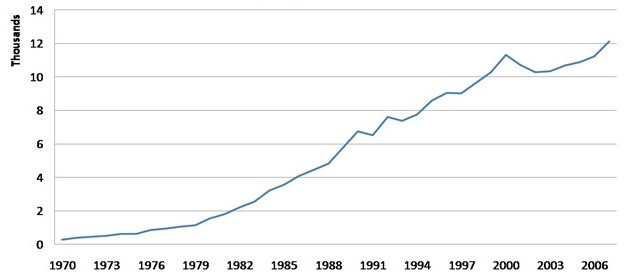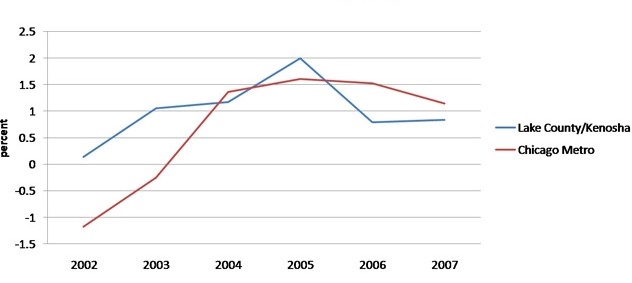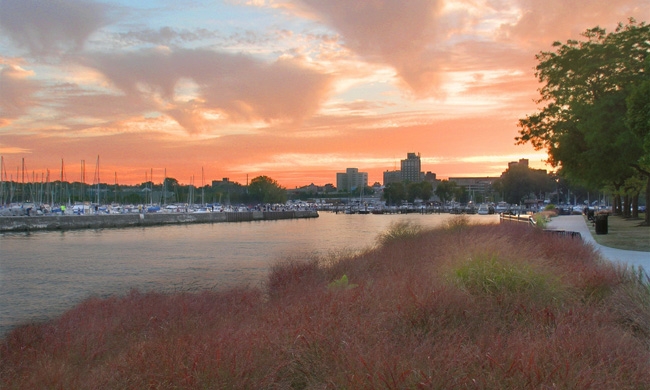Waukegan’s Economy and Development
Waukegan, IL, has responded to the challenges of a diminished manufacturing base by looking to its assets and opportunities. Over the past decade, the U.S. has experienced steep declines in manufacturing jobs, especially in Midwest towns—the heart of the industrial belt. Many of these same towns have come to recognize that manufacturing may never be what it once was for them. Therefore, while continuing to tend their remaining industries, they have also been making plans to integrate themselves into the growing knowledge-based economy. In developing workplace and residential amenities, these towns are now targeting a new “creative class” of workers who can possibly revitalize these once manufacturing-dependent areas.
Waukegan, IL, with a population of 92,066 1, lies 40 miles north of Chicago, on the coast of Lake Michigan in Lake County. Over the past 40 years, Waukegan has seen a sharp decline in its manufacturing sector. In 1972, Waukegan had 10,100 manufacturing jobs; approximately 15.5% of its total work force. By 2002, manufacturing employment numbers had dropped down to 4,780, making up only about 5% of Waukegan’s work force 2. During the 1970s and 1980s, Waukegan experienced a number of plant closures, for example U.S. Steel’s mill, which took away a few thousand jobs. Another plant closure was that of Johns-Manville—at the time an asbestos manufacturer. Another local manufacturer, Outboard Marine Corporation (OMC), began downsizing its operations over the past few decades until it filed for bankruptcy in 2000, laying off 7,000 employees from all of its plants. While OMC’s assets were acquired from the bankruptcy court by Bombardier Corporation which moved manufacturing operations north to Pleasant Prairie, Wisconsin, the research & development operations are still located on Waukegan’s lakefront.
Such economic changes have meant, not only diminished employment opportunities, but stresses on the local tax base to finance school and municipal services. At the same time, public service requirements have grown along with the city’s swelling population. Waukegan’s population expanded by 27% in the 1990s decade alone. As seen below, the most significant change has been the rapid growth of its foreign-born population, which increased 148% between 1990 and 2000. Most of these immigrants are recent arrivals to the U.S. (within the last ten years).
Table 1. Key facts about Waukegan, Illinois

In appraising its opportunities for redevelopment and growth, it appears possible for Waukegan to link its economy to the surrounding prosperity. Towns in Lake County and in nearby Kenosha County have generally enjoyed rising prosperity. As seen below, Lake County has registered consistently higher annual per capita personal income relative to that of the Chicago metropolitan area. The trend seems to show a continued growth in the income gap, as it widened to just over $12,000 in 2007. The second chart below shows that the pace of total employment in the Lake County/Kenosha area has been positive on a year over year basis since 2002, whereas the pace of total employment in the Chicago Metro area only turned positive between 2003 and 2004. The Lake County/Kenosha area’s growth rate reached a plateau in 2005 at 2.0%; although this fell to 0.8% in 2006, it has been steadily rising since then. Even with its own decline in manufacturing jobs, Lake County, between 2001 and 2007, has seen a consistent growth in the number of total jobs; its manufacturing job losses have been offset by new jobs in other sectors.
Figure 1. Difference between Lake county and Chicago metro per capita personal income

Source: BEA/Haver Analytics
Figure 2. Total employment percent change (year-over-year)

Accordingly, some Lake County towns are actively transforming themselves by expanding their residential amenities for the workers who occupy emerging jobs throughout the broader region. Nearby towns with a similar manufacturing heritage to that of Waukgean (e.g., Kenosha, WI) have already started implementing development plans emphasizing such amenities—e.g., by building condominiums on the lakefront (namely, HarborPark) and creating city parks along the lake. Besides the growing job base in Lake County itself, Waukegan and other towns throughout the county may be able to attract workers from Chicago and Milwaukee. Waukegan is situated between these two large and prosperous job markets. With appropriate development, greater numbers of new and existing Waukegan residents could one day find themselves commuting to these larger job centers.
So what types of projects is Waukegan undertaking to attract knowledge-based workers? For starters, Waukegan is currently in the process of a large multi-million dollar downtown and lakefront revitalization project. Waukegan seemingly has a myriad of opportunities to build up the community by enhancing currently underutilized resources. The town has 1,400 acres of property and 3.5 miles of Lake Michigan coastline to work with—one of the last remaining underdeveloped lakefront areas in the Chicagoland area. The city already has established assets, too. It boasts two harbors—one built as recently as the mid-1980s and substantially upgraded within the last year. Together, these harbors can hold nearly 1,000 boats of a variety of sizes, and both are relatively quiet and peaceful. Other marina-based businesses nearby offer further amenities for recreational boaters. In addition, the Genesee Theatre, which was the start of the city’s plan to transform the downtown area, finished its renovation in 2003, after being vacant for more than a decade. The total cost of the renovation was $23 million, but now the Genesee Theatre has become a destination spot, drawing attendees from both Illinois and Wisconsin.
Figure 3. Waukegan harbor skyline

In the process of its revitalization, Waukegan has created a master plan to guide its development, which focuses on two main things: being a great city and having great places. The master plan’s guiding principles include an emphasis on transit-oriented development; connections between the downtown and the lakefront; protecting, restoring and enhancing the ravine and park system; ecological restoration to create recreational amenities; improving the transportation framework to provide clear access and establish civic places. As part of its redevelopment effort, the city plans to build up to 3,700 new residential units along the lakefront to take advantage of this vital asset which has been long underutilized. They are looking to restore the facades of the historical buildings in the downtown to bring back the ambiance they once provided; for the most part, Waukegan will maintain their distinctive appearance, but also retrofit their facilities to modern use. The town plans to use tax incremental financing (TIF) dollars to help subsidize these changes, and several projects have already been completed. Along with the buildings, Waukegan has begun improvements to the downtown area by adding 16 blocks of streetscape, and Waukegan Park District has developed a new veteran’s memorial park as a public open space in the downtown. In addition, Waukegan plans to enhance its lakefront area that gives it a distinctive advantage over other cities, especially since it boasts a commuter rail, Metra stop, within walking distance of the lakefront and downtown. Rather than build up all the area around Lake Michigan, the city wants to design a large open space for community use and entertainment similar to Chicago’s Millennium Park, but on a smaller scale,as well as maintaining a public open space along much of the lake shore.
In conjunction with the city’s revitalization, steps need to be taken to clean the Waukegan Harbor further. The harbor was classified as an area of concern (AoC) in 1975 when toxic polychlorinated biphenyls (PCBs) were found in the sediments of the water related to the past industrial uses along the lakefront. During 1993, OMC completed environmental remediation by cleaning up the sediments in and around its property, removing about 1 million pounds of contaminated sediment. According to the environmental protection agency (EPA) website, OMC is not alone as other major remedial actions have been undertaken at Waukegan Manufactured Gas and Coke, Johns-Manville Company, Waukegan Paint and Lacquer, North Shore Gas North Plant, and the Waukegan Tar Pit.” If such actions continue, the goal would be to get the harbor off the AoC list, which would help advance Waukegan’s plans to revitalize the lakefront.
In sum, Waukegan’s city planners want to revitalize and transform Waukegan as a place for people who desire the amenities that a lakefront offers, but perhaps at a more affordable price. Their efforts might make Waukegan also appealing to those who prefer the quieter suburban lifestyle or those who can commute easily to jobs in Lake County, Milwaukee, or Chicago. Waukegan is hoping to rebuild its community and bring residential interest, commercial activity, and people back into a once booming industrial town.
Footntoes
1 2006 Census Estimate
2 Census of Manufactures Geographic Series 1972 and 2002








